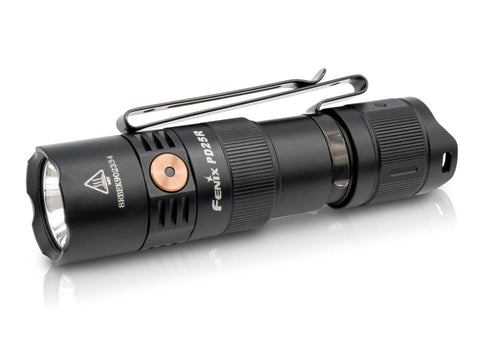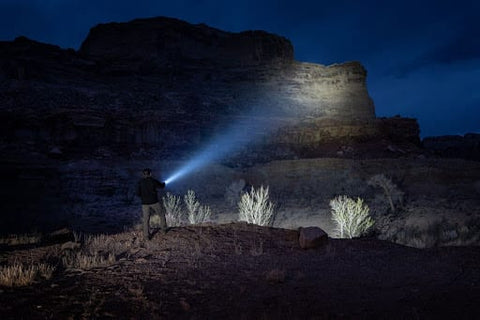Are you overwhelmed by the vast selection of flashlights available on the market? Do you need help differentiating between lumens and candelas or rechargeable and non-rechargeable flashlight batteries? You're not alone! Choosing the best flashlight can be daunting, but with Fenix Lighting, you'll learn how to make an informed decision and find the perfect light.
As a trusted industry leader with a long-standing reputation for producing high-quality lighting products, Fenix Lighting is your ultimate guide to all things flashlights. So whether you're a seasoned outdoor adventurer or looking for a reliable flashlight for everyday use, we've got you covered. Let's get started!
Table of Contents
- Types of Flashlights
- Flashlight Features
- Choosing a Flashlight
- Maintaining and Using a Flashlight
- Flashlight Batteries
Types of Flashlights
What’s the Difference Between Incandescent and LED Flashlights and Which One Should You Pick?
Incandescent flashlights use a filament and battery to produce light. They are often less expensive than other flashlights and have a warmer, natural color temperature. However, they are less energy efficient and have a shorter lifespan than LED flashlights. For these reasons, incandescent flashlights are quickly becoming a rarity.
LED flashlights, like the Fenix PD25R, use light-emitting diodes to produce light. These flashlights are more energy efficient, have a longer lifespan, and cast a brighter light. The PD25R can throw a maximum of 800 lumens on turbo. LED flashlights may be more expensive than incandescent flashlights but offer superior performance and durability, making them ideal for travelers and outdoor enthusiasts. Whether you need a reliable light source for camping, hiking, or unexpected situations, an LED flashlight is the way to go.
What’s the Difference Between Rechargeable and Non-Rechargeable Flashlight Batteries?
Rechargeable batteries, like in the Fenix PD35R, are more eco-friendly and cost-effective, eliminating the need to constantly buy new batteries. Rechargeable batteries have a higher capacity than non-rechargeable batteries allowing them to produce brighter, longer lasting light. However, non-rechargeable batteries, like AAs, are cheaper to purchase and more readily available. Choosing between rechargeable and non-rechargeable batteries will ultimately depend on your needs and preferences.
What Are the Types of Flashlights Available?
There are several types of flashlights available to suit different needs:
- Tactical lights like the Fenix TK20R V2.0 are designed for extreme conditions and have a rugged construction and powerful output.
- EDC flashlights like the versatile Fenix PD25R are compact and lightweight, making them easy to carry in your pocket or bag.
- Penlights like the Fenix T6 are small and slim, designed to resemble a pen (the T6 is a 2-in-1 writing instrument and penlight), making them ideal for medical professionals and technicians who need a small but bright light source.
- Keychain flashlights like the Fenix E03R V2.0 are the smallest type and can be easily attached to a keyring for convenient access.
When Should You Choose a Headlamp Over a Flashlight?
Headlamps, like the all-purpose Fenix HM60R, are ideal when you need a hands-free lighting solution. They are particularly useful for activities where you need both hands, such as fishing, hunting, caving, and maintenance work.
A headlamp provides a constant, stable light source, which you can adjust to aim in different directions. Some headlamps, like the Fenix HL18R-T, have a SPORT headband which allows you to dial in a precise fit , making them more comfortable to wear for extended periods.
Flashlight Features
What’s the Difference Between Lumens and Candelas in Flashlights?
Lumens and candela are both a measurement of light. However, while lumens is a measure of the total light output, candela is a measure of light intensity in a specific direction.
A flashlight with a high lumen output will illuminate a large area while a flashlight with a high candela will illuminate a more concentrated area with a bright light.
Can Flashlights Be Waterproof?
Many flashlights are designed for use in damp settings, such as during camping trips, hiking, boating, or other extreme environments. These lights are typically certified with an Ingress Protection rating, which indicates the degree of protection against dust and water.
For example, the Fenix E18R V2.0’s IP68-rated protection makes it waterproof underwater to 6.6 ft (2 m). In addition, flashlights with waterproofing capabilities often feature O-ring seals and waterproof casing to prevent water from entering the internal components of the flashlight.
Regularly inspecting the flashlight for signs of wear or damage and properly drying it after getting wet can help to prolong its lifespan and ensure it remains waterproof.
What Is a Flashlight’s Maximum Beam Distance?
A flashlight's maximum beam distance is the farthest the flashlight can effectively illuminate an object. This distance is typically measured in meters or feet.
Consider a flashlight's maximum beam distance when choosing one for activities such as search and rescue. The beam distance will determine how far ahead you can see and navigate in low-light conditions. The Fenix LR50R is a high-performance flashlight that can throw a maximum of 12000 lumens across a distance of 3117 ft (950 m), making it ideal for search-and-rescue operations.
Choosing a Flashlight
How Do I Choose the Best Flashlight for My Needs?
When choosing a light, consider the activities you'll use it for, such as commuting, running, or working in low-light conditions.
Look for a flashlight with a suitable beam distance, brightness level for your needs, and a durable and waterproof construction if you'll use it in wet or rugged environments. Also, consider the light's batteries, runtime, and rechargeability to ensure it lasts as long as you may typically need.
Check out our helpful guides on finding the best flashlights for specific activities and professions:
- Best tactical flashlights of 2022
- How to select the best tactical flashlight
- Best hunting flashlights
- How to select the best hunting flashlight
- Best rechargeable work flashlights for truckers
How Much Should I Expect To Spend on a Good-Quality Flashlight?
The price of a good-quality flashlight can vary widely depending on its features, construction, and brand. Generally, expect to pay between $30 and $100 for a reliable, durable light. However, the price can be higher if you require specialized features or high-end components.
Some Fenix lights, like the E01 V2.0, are as low as $13, and others, like the LR50R, are as high as $320. Ultimately, it's best to consider the flashlight's value in relation to your needs and budget when purchasing. If you are looking for lights under $100, check out our blog post for our recommendations.
Maintaining and Using a Flashlight
How Do I Maintain My Flashlight?
Proper maintenance prolongs a flashlight’s lifespan and ensures optimal performance. To maintain your light:
- Regularly inspect it for signs of wear or damage
- Clean the lens and casing with a soft cloth and mild soap
- Make sure the batteries are always charged or replaced as needed
- Store the light in a dry, cool place when not in use to prevent corrosion and damage to the internal components.
While a flashlight may be waterproof, it's best to maintain and care for it to ensure it remains in good condition.
Can I Use Flashlights For Self-Defense?
While flashlights are not designed specifically for self-defense, they can be used to disorient or strike an assailant. Some tactical flashlights, like the Fenix TK16 V2.0, are designed with features like strobe modes or tungsten steel strike bezel that can be used for self-defense. However, it's important to remember that a flashlight should not be relied upon as a primary self-defense tool and that proper training and situational awareness are crucial for personal safety.
How Do I Know When My Flashlight Battery Is Low or Needs Replacing?
Most flashlights will show signs when the battery is low or needs replacing, such as the beam dimming or flickering or a decrease in brightness or beam distance. Some lights, like the Fenix TK35UE V2.0, have a handy battery level indicator that lets you know when the light is low on power.
Are Flashlights Reliable in Extreme Weather??
While most flashlights can withstand various temperatures, extreme hot or cold environments may affect their performance. High temperatures can cause batteries to degrade rapidly, while cold temperatures may drain batteries faster and reduce beam brightness and distance. Many Fenix flashlights, like the PD36 TAC, have industrial components that withstand severe heat and cold. Consider the temperature range in which you'll use your flashlight and choose a model designed to withstand those conditions.
Are There Laws or Regulations Regarding Flashlight Use?
In most cases, there are no specific laws or regulations regarding flashlight use. However, be mindful of others when using your light in public, and avoid shining it in people's eyes. Additionally, some municipalities have specific rules regarding using high-powered flashlights or using flashlights in specific areas.
Can I Travel With Flashlights?
Generally, you can travel with flashlights in luggage or carry-on bags. Still, check with airlines or the TSA to ensure there are no specific restrictions or regulations regarding the type or size of flashlight you can bring. Additionally, while traveling internationally, be mindful of local laws and regulations regarding flashlight ownership and use.
Flashlight Batteries
What Types of Batteries Do Flashlights Use?
Flashlights can use various batteries, including disposable alkaline, rechargeable lithium-ion, and rechargeable NiMH batteries. The battery your flashlight uses depends on the model and manufacturer, so check the specifications and recommendations for your specific flashlight. Additionally, it's a good idea to choose high-quality batteries appropriate for your light's power needs to ensure optimal performance.
How Long Do Flashlight Batteries Last?
The lifespan of flashlight batteries can vary widely depending on the battery type and quality and the light’s power demands. For example, disposable alkaline batteries may last a few hours to several days, while rechargeable batteries often provide longer runtimes with proper charging and maintenance. You can top off rechargeable batteries with a portable battery charger, like the Fenix ARE-D1.
Get Answers to Your Flashlight Questions With Fenix
Choosing the best flashlight for your needs can seem overwhelming, but understanding the different types, features, and specifications will help you make an informed decision. Whether you're an outdoor enthusiast, a medical professional, or someone who wants a reliable light source for everyday use, there is a Fenix flashlight for you.








